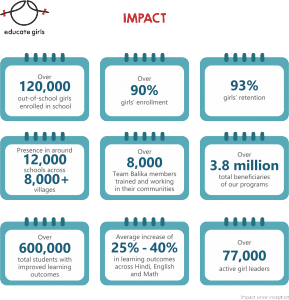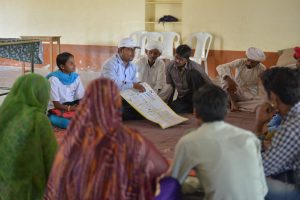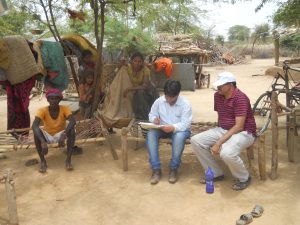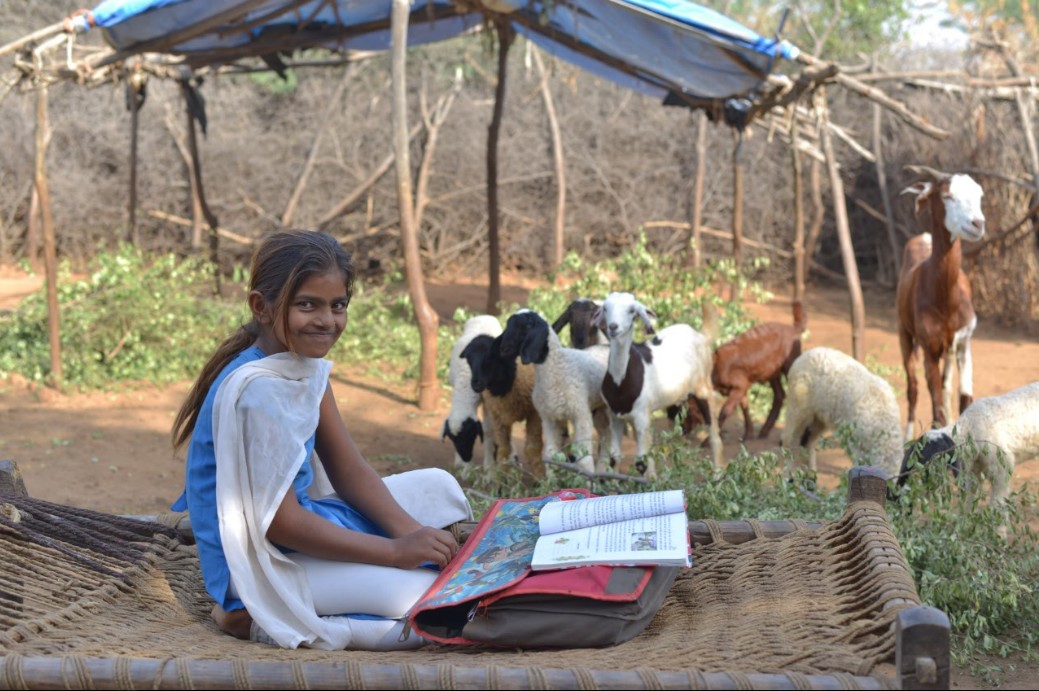Achieving SDG4 of Inclusive & Quality Education: Community, Data and Collaboration
The majority of the UN Sustainable Development Goals are inextricably linked to one another, none more so than goals four and five. My organization, Educate Girls, works at the intersection of these two goals—namely SDG4 Education and SDG5 Gender Equality. It is appropriate, that they fall in that order, as I believe fundamentally that education is the “route to” and “root of” gender equality.
In her eloquent contribution to this series Irina Bokova, director general of UNESCO, lays out clearly the background to SDG4. In this contribution, I will seek to provide evidence from the community level, where Educate Girls has been working for the last 10 years in some of the most patriarchal and discriminatory communities in the world.
Bokova calls on the world to focus on “those who have been left behind”, highlighting girls as “a huge driver of development.” It is exactly here that Educate Girls begins its work, and by “left behind”, Educate Girls means, not only those girls left out of education, excluded by economic, social or cultural barriers, but also those who may have managed to reach school, but are being left behind by a system that is consistently failing them. India is currently seeing a decline in learning outcomes, and at Educate Girls we are striving to change that and create ways in which the current system can offer an education worth having.
Related article: Developing a Holistic Approach Empowering Women and Girls
As we move into our 10th year of aligning with the Global Goals, we continue to put girls at the forefront of all our work, and at the same time place a renewed focus on the achievement of learning outcomes and a quality education through the government school system. As the SDGs expand to include secondary education, so too Educate Girls will pilot a new program to enroll and support girls in their transition to secondary school, launching in the 2017 school year.
EDUCATING GIRLS: THE STORY SO FAR
Established in 2007, Educate Girls staff leverage community volunteers and the government school system, to get out of school girls in rural India into school and learning. The organization is holistically tackling issues at the root cause of gender inequality in India’s education system, and to date has helped to ensure over 90 percent enrollment and higher attendance of girls. As well as improved school infrastructure, improved quality of education and increased learning outcomes for boys and girls, in some of the most marginalized communities in India.

After a 50-school pilot in 2007, we immediately scaled up to 500 schools and then incrementally increased our outreach to 12,500 schools across two states by 2016. Educate Girls has now enrolled over 120,000 girls into school and improved learning outcomes for over 600,000 boys and girls and has over 3, 800 000 beneficiaries of the program.
In order to meet the targets for the SDG4, I believe there are three key pillars for success:
- Finding solutions that are delivered for the community, by the community.
- Using data to ensure accountability to the children we are trying to reach and who make up these “targets” we are aspiring to achieve.
- Fostering new and better ways for government, civil society and the private sector to partner successfully and deliver sustained change.
1. VILLAGE LEVEL CHAMPIONS FOR GIRLS’ EDUCATION
The Millennium Development Goals (MDG) attempt to reach universal primary education saw the largest scale enrollment campaign the world has ever seen, and yet with the influx of first generation learners into the classroom, came falling learning outcomes and as a result a massive global learning crisis. The International Commission for Funding Global Education Opportunities estimates that without dramatic change, by 2030, 69 percent of children in low income countries will not learn basic primary level skills.
 Photo Credit: Educate Girls
Photo Credit: Educate Girls
When the MDGs were set, perhaps tackling barriers to education at the same time as quality in the classroom seemed too much to work on simultaneously, but it is clear now that this was a mistake. Educate Girls has come up with a highly effective approach that tackles enrollment of excluded girls, at the same time as improving learning outcomes for all children and centers, around the engagement of a community level volunteer in every village to work on both enrollment plans and as teaching assistants in the classroom. Educate Girls’ Team Balika (Girl Champion) volunteers are from the village they work in, and have unique insight into the culture and social norms of the village.
Our model is built upon the recruitment, training and motivation of such young people to give back to their own community and champion the rights of girls, whilst building skills and gaining valuable work experience that will enable them to improve their own livelihood opportunities in the future. Such an approach provides our program with local cultural knowledge, community access, appropriate mentorship and regular intervention. By embedding the behavior change shift in the community, we have the opportunity for sustainability as we exit out of villages.
But not only do the volunteers work to enroll the girls, and shift mindset at the household and village level, they work in school. With modest training in creative learning and teaching they take on the role of a teaching assistant alongside government teachers. In a recent randomized control trial, children in schools with one of our Team Balika teaching assistants, increased their learning gains by 30 percent.
One Team Balika member, Satyanarayan, explains: “I somehow never liked the way my sisters were discriminated against. I used to offer to do a lot of the household chores but my mother wouldn’t let me. I have completed BA and BEd. Degrees but always regretted that I didn’t have a chance to fight for their education before they were married. That is why paving the way for education in my village is a cause close to my heart.”
Satynarayan has four older sisters all who are now married and were excluded from school. He now works as a Team Balika enrolling girls into school and conducting lessons in the classroom.
2. ARE WE REACHING WHO WE SAY WE ARE?
Out of school girls are often invisible to the world. How can you work with the hardest to reach girls if you don’t know where they are?
Data is an undisputed driver of successful development, and a lack of data is often a key cause of roadblocks, when trying to engage with some of the hardest to reach communities. Indian Government statistics on out of school children are disappointingly out of date and hence Educate Girls’ large scale enrollment campaigns are becoming of increasing importance in ensuring accountability to global targets.
 Photo Credit: Educate Girls
Photo Credit: Educate Girls
Before our activities are conducted in a community, Educate Girls staff go door to door and conduct a thorough census-like survey, to identify out of school girls and collect additional data on their family, environment and the barriers to girls’ enrollment. In the last school year Educate Girls’ door to door survey included over 2, 000 000 households, giving us incredible insight into what is holding girls back from school, where the barriers are highest and ensuring that every girl is accounted for.
3. SYSTEM CHANGE THROUGH PARTNERSHIP
Educate Girls is a great believer in the critical importance of the government education system to reach the most at risk, and has from the very beginning worked in close collaboration with the Government of Rajasthan and district administrations. Our program ensures that no parallel system is created and we “enable” rather than “substitute” government. We help communities assess their own school situation, initiate and deliver to local government action plans, and sustain positive results at the lowest cost within the government system. We work with School Management Committees and train the villagers themselves to drive the change and access government resources that are all too often not delivered as committed.
But our work is not financially self-sustaining as it requires additional resourcing, beyond the funds provided by the government in the early years of the program, and this is where the private sector comes in.
As the Learning Generation report worryingly concludes, international financing for education will need to increase from today’s estimated $16,000,000,000 per year to $89,000,000,000 per year by 2030, or to an annual average of $44,000,000,000 between 2015 to 2030. That gap, unless filled as soon as possible, will result in a failure to meet SDG4. Governments alone will be unable to meet this need and so a role for the private sector has to be identified, that goes beyond the financing of low-cost private initiatives, and beyond pure philanthropy (two obvious and much-needed roles for private sector funding but not the only roles).
One innovative funding instrument that might play a critical role is the “social” or “development” impact bond—a funding model that has the potential to unlock new and more capital but also build much greater accountability mechanisms to measurable education outcomes. Educate Girls has for the last two years been piloting the world’s first DIB in education, that brings a sharper focus on results and a new way of partnering across civil society, government and the private sector.
The model is essentially a result based funding mechanism that enables the end funder to only pay for outcomes. However, it reduces the risk to the service provider by providing up front capital from an additional funder. The government is not yet involved in this proof of concept, however, it is hoped that the DIB model could enable government education ministries to commit a much larger quantum of funding for education programs, as they will only pay for successful outcomes with the philanthropic and private sector, bearing the risk and providing the upfront funding. It is thought that funds will be attracted to this approach as there is the opportunity to earn modest interest on their money, so their capital can be put to work, whilst delivering a social return and then of course “recycled”.
We have to end in hope. ‘The Learning Generation’ report concludes that it will be possible to get all young people into school and learning within a generation—despite the scale of the challenge. However, we have to focus on community level change for it to be sustainable, data to bring genuine accountability to each and every child, and innovative partnerships for both implementation and funding of the solution. At Educate Girls we are optimistic about the future but call on the world to listen to the stories of change from the field and learn from what we believe is working. For every year, a girl is out of school her future dims and the power of educating girls is now undisputed.
I believe that SDG4, ensuring equitable and inclusive quality education, particularly of girls, will be the driver of not just SDG5 but all the 17 goals.
So, let’s get to work!
—-
To Learn More about Educate Girls:
Website: www.educategirls.ngo
Facebook: www.facebook.com/educategirls
Twitter: www.twitter.com/educate_girls
Editor’s Note: The opinions expressed here by Impakter.com columnists are their own, not those of Impakter.com. — Featured Photo Credit: Educate Girls









